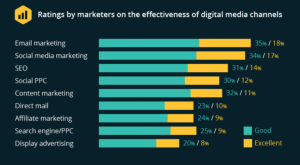One of the most critical campaign types for your eCommerce marketing strategy is Google Ads remarketing. Google remarketing takes the search power of Google and enables you to reach your target shoppers – those who are already familiar with your brand and products – well after they have left your store.
Google Ads remarketing campaigns statistically result in lower CPCs, but that’s not their top benefit. Because there is already brand awareness, there is a big chance that remarketing CTRs will be higher, which in turn means more conversion potential. Who wouldn’t want more clicks and conversions for less spend?
In this post, we look at everything eCommerce sellers need to know about Google Ads remarketing: from beginners’ set up to expert retargeting strategies and top optimization tips, so that you can capitalize on this powerful marketing tool to drive sales.
How Do Google Ads Remarketing Campaigns Work?
![Everything You Need to Know About Google Ads Remarketing [+ Expert Strategies] Everything You Need to Know About Google Ads Remarketing [+ Expert Strategies]](https://www.onlinesalesguidetip.com/wp-content/uploads/2019/11/01-Everything-You-Need-to-Know-About-Google-Ads-Remarketing-Expert-Strategies.png)
By using browser cookies generated by a Google remarketing tag placed on your website, categories and pages, Google allows advertisers to retarget previous site visitors based on their behavior while browsing your store. This enables you to show ads to potential shoppers who already know your brand while they are browsing Google or partner sites, by using remarketing lists.
Newbie Tip: How to Set Up Remarketing Codes
Step 1: Make sure you have had at least 1,000 active visitors or users within the last 30 days for Search remarketing, or 100 active visitors or users within the last 30 days.
Step 2: Add your global site tag and the optional event snippet.
![Everything You Need to Know About Google Ads Remarketing [+ Expert Strategies] Everything You Need to Know About Google Ads Remarketing [+ Expert Strategies]](https://www.onlinesalesguidetip.com/wp-content/uploads/2019/11/02-Everything-You-Need-to-Know-About-Google-Ads-Remarketing-Expert-Strategies.jpg)
Alternatively, this can be done with a Google Analytics tracking code – but more on that later!
Google Ads Remarketing Options for eCommerce
Google Ads remarketing options include standard remarketing, remarketing lists for Google Shopping, dynamic remarketing, remarketing lists for Search ads, video remarketing and customer list remarketing. Let’s take a look at each.
1. Display Remarketing
Google Display Network (GDN) remarketing ads allow you to show ads to previous store visitors while they browse other sites and apps. Some advantages of Display Network remarketing include:
- Ability to create highly-targeted, segmented campaigns that improve campaign messaging that ups your chance of results
- Keeping your brand front and center in the minds of your potential shoppers, AKA consistent brand exposure
- Lower CPCs and better budget control
- A broad reach, with access to more than 2 million websites and 90% of internet users
Here are examples from two of our top Traffic Booster merchants, Beautiful Disaster and One Kid:
![Everything You Need to Know About Google Ads Remarketing [+ Expert Strategies] Everything You Need to Know About Google Ads Remarketing [+ Expert Strategies]](https://www.onlinesalesguidetip.com/wp-content/uploads/2019/11/03-Everything-You-Need-to-Know-About-Google-Ads-Remarketing-Expert-Strategies.jpg)
![Everything You Need to Know About Google Ads Remarketing [+ Expert Strategies] Everything You Need to Know About Google Ads Remarketing [+ Expert Strategies]](https://www.onlinesalesguidetip.com/wp-content/uploads/2019/11/04-Everything-You-Need-to-Know-About-Google-Ads-Remarketing-Expert-Strategies.jpg)
2. Remarketing Lists for Google Shopping
![Everything You Need to Know About Google Ads Remarketing [+ Expert Strategies] Everything You Need to Know About Google Ads Remarketing [+ Expert Strategies]](https://www.onlinesalesguidetip.com/wp-content/uploads/2019/11/05-Everything-You-Need-to-Know-About-Google-Ads-Remarketing-Expert-Strategies.png)
As the name suggests, these are remarketing lists used for your Google Shopping ads. Combining Google Shopping campaigns with remarketing lists can be hugely powerful because you are able to more segment targeting audiences and refine your messaging to searchers actively looking for the products you’re selling.
Here are Google’s instructions on how to add remarketing lists to Shopping campaigns:
Instructions
- Create a new “Shopping” campaign, or select an existing Shopping campaign and ad group.
- From the page menu along the left, click Audiences.
- Click the pencil icon
![Everything You Need to Know About Google Ads Remarketing [+ Expert Strategies] Everything You Need to Know About Google Ads Remarketing [+ Expert Strategies]](https://www.onlinesalesguidetip.com/wp-content/uploads/2019/11/06-Everything-You-Need-to-Know-About-Google-Ads-Remarketing-Expert-Strategies.png) .
.
- Under “Add to” select “Campaign” or “Ad group” depending on which level you want to apply the audiences.
- Select a remarketing list by checking the box next to it. To select all remarketing lists, click the checkbox near the “Audience” column header.
- Next to “Add to” select either “Select a campaign” or “Select an ad group,” depending on which “Add to” option you have previously selected.
- For the option to add to a campaign:
- Select the campaign which you’d like to target your list.
- Choose the targeting method of either “Targeting” or “Observation.” To learn more about these targeting options read About Targeting and Observations for Display Network campaigns.
- (Optional) Add additional remarketing lists or in-market audiences to your campaign.
- Select a campaign and then an ad group..
- Choose the targeting method of either “Targeting” or “Observation.”
- (Optional) Add additional remarketing lists or in-market audiences to your ad group.
3. Dynamic Remarketing
The next Google retargeting option is dynamic remarketing, which takes Google remarketing to the next level. With dynamic remarketing, advertisers are able to show ads that contain highly-tailored messages and products to previous store visitors. Its benefits include:
- Dynamic ad layout, which ensures the ad matches the person viewing or the platform they are viewing it on
- Paired product feed with Dynamic ads, which means automatic ad scaling that covers your entire inventory
- Real-time automatic bid optimization for enhanced CPCs
![Everything You Need to Know About Google Ads Remarketing [+ Expert Strategies] Everything You Need to Know About Google Ads Remarketing [+ Expert Strategies]](https://www.onlinesalesguidetip.com/wp-content/uploads/2019/11/07-Everything-You-Need-to-Know-About-Google-Ads-Remarketing-Expert-Strategies.png)
Newbie Tip: Before you start with Dynamic ads, you will need to create a product feed, add a dynamic remarketing tag and create responsive ads in the ad gallery. Visit our beginner’s Dynamic Search Ads (DSA) Guide for detailed steps.
4. Remarketing Lists for Search Ads
![Everything You Need to Know About Google Ads Remarketing [+ Expert Strategies] Everything You Need to Know About Google Ads Remarketing [+ Expert Strategies]](https://www.onlinesalesguidetip.com/wp-content/uploads/2019/11/08-Everything-You-Need-to-Know-About-Google-Ads-Remarketing-Expert-Strategies.jpg)
Remarketing lists for Search ads enable eCommerce store owners to retarget potential or previous shoppers on SERP pages. Like with all remarketing campaigns, using remarketing lists for Search ads can produce higher click-through rates for lower CPCs.
5. Video Remarketing
Another remarketing opportunity Google offers is video remarketing. Here, you are able to retarget potential shoppers who interacted with your YouTube videos or channel in some way, or use remarketing lists for your video campaigns. The latter means you can create personalized, tailored ads that are seen on YouTube, Google video partner sites and in Search. One such campaign strategy that has proved successful is using YouTube to remarket to cart abandoners; you can learn how to do that here.
New to video remarketing? Here are Google’s instructions on how to create video remarketing lists:
![Everything You Need to Know About Google Ads Remarketing [+ Expert Strategies] Everything You Need to Know About Google Ads Remarketing [+ Expert Strategies]](https://www.onlinesalesguidetip.com/wp-content/uploads/2019/11/09-Everything-You-Need-to-Know-About-Google-Ads-Remarketing-Expert-Strategies.jpg)
6. Customer List Remarketing
The last Google retargeting option worth testing is your customer list remarketing. As the name suggests, it’s a way for you to upload lists of contact information, so that they see your ads when they log in to various Google products. Used with the Customer Match ad feature, it is currently only available on Search, Shopping, YouTube, Gmail and Display. Here’s how Customer Match works:
![Everything You Need to Know About Google Ads Remarketing [+ Expert Strategies] Everything You Need to Know About Google Ads Remarketing [+ Expert Strategies]](https://www.onlinesalesguidetip.com/wp-content/uploads/2019/11/10-Everything-You-Need-to-Know-About-Google-Ads-Remarketing-Expert-Strategies.jpg)
Google Analytics vs. Google Ads Remarketing List Tags
Before you create your Google remarketing campaigns, you will need to create your remarketing lists – which you will need a website tag. Remember the Google Ads remarketing tag and Analytics tracking code we mentioned earlier?
By generating your tag in Analytics, you will be able to build remarketing audiences from any of the data you have in Analytics; while by using Google Ads to create tags and lists you are only able to build remarketing lists from the data collected by the remarketing tag. Here’s a breakdown of the differences between creating remarketing lists in Google Ads and Analytics.
Tips for Creating Your Remarketing Audiences
Once your tags are in place, you will need to create your audience. Here you will name your audience, set your rules on which site visitors to include in the audience, set your initial size limits and choose a membership duration.
![Everything You Need to Know About Google Ads Remarketing [+ Expert Strategies] Everything You Need to Know About Google Ads Remarketing [+ Expert Strategies]](https://www.onlinesalesguidetip.com/wp-content/uploads/2019/11/11-Everything-You-Need-to-Know-About-Google-Ads-Remarketing-Expert-Strategies.jpg)
Let’s talk a bit about an important audience-creation feature – membership duration. This is the amount of time you want to store a cookie in a user’s browser and can’t exceed 540 days.
Choosing your membership duration will depend on your business and goals. Let’s say you have a store selling luxury or expensive products, where your shoppers generally only spend every six months. In this case, you may want to have a more extended membership. While an online store with products that are purchased more often should consider a 90-day membership.
![Everything You Need to Know About Google Ads Remarketing [+ Expert Strategies] Everything You Need to Know About Google Ads Remarketing [+ Expert Strategies]](https://www.onlinesalesguidetip.com/wp-content/uploads/2019/11/12-Everything-You-Need-to-Know-About-Google-Ads-Remarketing-Expert-Strategies.jpg)
In short, look at your own business model, customer data and the products you sell, and test membership variations until you find what suits your store.
12 Top Google Ads Remarketing Audiences & Campaign Types
Now that you’re all caught up with remarketing tags, lists and options, it’s time to build your Google remarketing campaigns. Here are the top Google remarketing strategies every online seller should test.
Remarketing Strategy #1: Abandoned Cart Campaigns
One of the most important remarketing strategies eCommerce entrepreneurs should be using is abandoned cart remarketing campaigns.
As you know, cart abandonment is common with eCommerce brands – even if you have optimized against the top reasons shoppers are abandoning their online carts. Therefore, if you have a store with good traffic and engagement, even if you have done everything right, you’re going to have looky-loos who come into your store to browse around, resulting in cart abandonment. Running remarketing campaigns will help you bring those shoppers back to your site. Here are two audiences you can try:
- Potential shoppers who clicked through to the cart page: Category page > Product page > Cart page
- Users who clicked through to the checkout page: Category page > Product page > Cart page > Checkout page
![Everything You Need to Know About Google Ads Remarketing [+ Expert Strategies] Everything You Need to Know About Google Ads Remarketing [+ Expert Strategies]](https://www.onlinesalesguidetip.com/wp-content/uploads/2019/11/13-Everything-You-Need-to-Know-About-Google-Ads-Remarketing-Expert-Strategies.jpg)
For each, you can create separate and segment your audiences even further to target specific cart abandoners who abandoned particular products.
Remarketing Strategy #2: Re-Engage Your Best Customers
We know that generally speaking, remarketing campaigns have a lower CPCs. We also know that repeat customers are not only cheaper but easier to convert. Therefore, taking the power of Google remarketing campaigns and using it to target your best customers can boost sales in a significant way. Use your Google remarketing campaigns to show your big spenders new product lines, products that match their previous purchase in terms of value or style, or simply create short VIP promotions.
Pro Tip: When creating remarketing lists of previous customers, segment them by not only how much or how often they spend, but the time period of their last purchase.
Remarketing Strategy #3: Send Traffic to Your Product Page Reviews
As any store owner who has been in the game for some time will tell you, reviews are a powerful conversion tool. Not only do they form the foundation of your eCommerce word-of-mouth strategy and build brand and product trust, but when used with remarketing can give those browsers just the push they need to shop.
There is another way to use product reviews in remarketing campaigns worth testing, and that’s taking your best product reviews and using them in your remarketing campaigns as copy and artwork.
Beginner Tip: Need help collecting product reviews and other UGC? Then this 5 Tools to Increase UGC post will help.
Remarketing Strategy #4: Cross-Selling Remarketing Campaigns
The next retargeting strategy every online seller should test is using your Google remarketing campaigns to cross-sell products to shoppers who have bought something from you recently. Here, you want to create a remarketing list of shoppers who have recently purchased a certain type of product within a certain time period. You can then create highly personalized campaigns aimed at those shoppers, that offer a complimentary product.
Pro Tip: Once the time period has ended, you can then move the non-converters into another group where you may offer a discount to secure the cross-sell. The possibilities are endless.
Remarketing Strategy #5: Seasonal Google Remarketing Campaigns
This remarketing strategy involves creating an audience of previous shoppers or site visitors who engaged with your store during a certain time frame. Let’s say you ran a Thanksgiving sale on certain products. Now let’s say you want to target that traffic again to let them know of a new sale or remind them of the products they were interested in. Then you would create an audience of “visitors who viewed a specific product page during specific dates.”
![Everything You Need to Know About Google Ads Remarketing [+ Expert Strategies] Everything You Need to Know About Google Ads Remarketing [+ Expert Strategies]](https://www.onlinesalesguidetip.com/wp-content/uploads/2019/11/14-Everything-You-Need-to-Know-About-Google-Ads-Remarketing-Expert-Strategies.jpg)
Remarketing Strategy #6: Remarketing Seasonal Products
Turning the above remarketing strategy on its head, this tactic enables you to remarket seasonal products to previous customers or traffic when they come back in season. Some examples are wedding-related products for wedding season, gardening equipment for spring or winter jackets at the beginning of the cold season.
Remarketing Strategy #7: Blog Visitors
If you have an eCommerce blog – one of the leading ways to generate eCommerce traffic – then this remarketing strategy is for you. If you’ve been working on your blog to get good organic traffic, then remarketing that traffic can bring it into your sales funnel with the added bonus of them already being familiar with your brand. More brand awareness = more trust!
![Everything You Need to Know About Google Ads Remarketing [+ Expert Strategies] Everything You Need to Know About Google Ads Remarketing [+ Expert Strategies]](https://www.onlinesalesguidetip.com/wp-content/uploads/2019/11/15-Everything-You-Need-to-Know-About-Google-Ads-Remarketing-Expert-Strategies.jpg)
Remarketing Strategy #8: Page Exclusions
Another way to create segmented remarketing audiences is to create a group of shoppers who haven’t visited a specific page but did visit another page.
![Everything You Need to Know About Google Ads Remarketing [+ Expert Strategies] Everything You Need to Know About Google Ads Remarketing [+ Expert Strategies]](https://www.onlinesalesguidetip.com/wp-content/uploads/2019/11/16-Everything-You-Need-to-Know-About-Google-Ads-Remarketing-Expert-Strategies.jpg)
A simple example of using this strategy would be if you wanted to target cart abandoners. You would create this by targeting those who visited the cart page but not the checkout page. Or those who visited the checkout page but didn’t visit the thank-you page after a purchase.
A more creative way to use this strategy would be if you wanted to target potential shoppers who still had questions about your brand. You could then target shoppers who visited your FAQ pages but exclude those who visited the cart page.
Remarketing Strategy #9: Dynamic Ads
If you’re not using remarketing lists with Dynamic ads, you’re missing out on a lot of conversion potential! As the name suggests, Dynamic ads allow you to dynamically create special messaging and offers depending on what products potential customers are interested in. And the best part is that Google does most of the heavy lifting for you.
Newbie Tip: If you’re a new store with fewer products and very little content, then Dynamic ads won’t be for you. You can read more about the requirements and how to set up Dynamic Search Ads here.
The benefits of Dynamic ads are powerful. They include automatic updates based on changes to your product feeds, extra keyword coverage, time efficiency, extended headlines and, most importantly, more targeted ads. All of which increase your chances of conversions. In one case study, an outdoor gear and outerwear brand generated a 5X higher conversion rate from using dynamic remarketing campaigns.
Pro Tip: Keep your dynamic remarketing campaigns focused on your products by using product-specific, high-quality images from your feeds. Visit our Ultimate Guide to Product Photography for eCommerce for more information on how to take your product photography to pro level.
Remarketing Strategy #10: Recurring Sales or Product Reminders
If you’re selling products that need to be topped up regularly, then you may want to consider running a regular remarketing campaign targeting previous traffic with recurring sales. With these campaigns, you may want to remind customers that it’s time to stock up again or that if they buy in bulk, they will get a discount. You can match these to segmented remarketing lists based on interest for those products, represented in your sales or reminders.
Remarketing Strategy #11: Product Views
Another strategy to test for your remarketing plan is targeting specific users who took an interest in specific products. In this strategy, you would create an audience of potential shoppers who have not converted yet, all of whom have viewed the same product pages. You would then use remarketing campaigns to remind these shoppers of the products they were viewing to bring them back to your store to shop. But remember, you will want to use those exclusions (of cart or checkout pages) again to ensure that your audience excludes cart abandoners, which you would be targeting in a different campaign tailored to them.
Remarketing Strategy #12: Purchasing History
As we know, it’s cheaper to build long-term, loyal customers than acquire new ones. There are several ways you can remarket customers based on purchasing history, with Google’s customer list remarketing feature. With customer lists, you can create audiences of previous shoppers based on things like the products they have purchased, the number of times they have shopped at your store or total purchase value – just to name a few!
Let’s say you’re an online leggings store that sells a variety of leggings and sports bras. You could target all shoppers who purchased a certain legging design with a sports bra, or other products that match in design. Or you could target your high-value regular shoppers with remarketing campaigns focused on newly released legging designs. In addition, let’s say you want to bring back shoppers from a previous promotion for Halloween; you could remarket previous Halloween purchasers with your new seasonal collection.
![Everything You Need to Know About Google Ads Remarketing [+ Expert Strategies] Everything You Need to Know About Google Ads Remarketing [+ Expert Strategies]](https://www.onlinesalesguidetip.com/wp-content/uploads/2019/11/17-Everything-You-Need-to-Know-About-Google-Ads-Remarketing-Expert-Strategies.jpg)
Newbie Tip: To be able to upload your customer lists to Google, you will need to have a minimum of 90 days’ history of ads, have spent more than $ 50,000 total lifetime spend and a strong payment history with Google where you have been compliant with Google Ads policies.
11 Google Ads Remarketing Optimization Tips and Hacks
We don’t have to tell you that as with any Google Ads campaign, it is not enough just to go live – you need to monitor, track, tweak and optimize to ensure you are getting the results you want for the spend you have. You also want to test before you throw all your budget into any campaign, and be sure you have a strong foundation to make optimization easier. Here are our top Google Ads remarketing optimization tips and hacks to get you started!
1. Segment, Segment, Segment
The first rule of any successful PPC campaign strategy is to segment your audiences so that you can fine-tune messaging to specific shoppers and therefore increase conversion chances. Google remarketing campaigns are no different – and to really succeed, you want to segment your audience into smaller groups based on specific interactions.
For example, a user who quickly viewed your homepage should be approached differently than potential shoppers who spent a lot of time considering your product pages, as they are at different stages of your sales funnel. In this case, you could create custom ads about price reduction sales to those shoppers who visited product pages but didn’t go further. Or for homepage lookers, your ads could be more focused on further brand awareness.
In short, audience segmentation is, therefore, the key to ensuring your Google remarketing campaigns are highly engaging as it enables message-specific ads that speak directly to a small group of potential shoppers, moving them up the sales funnel.
2. Split Your Campaigns
It’s not enough to just split your remarketing lists; you want to split your campaigns. In a nutshell, you want to create a campaign for each of your segmented audiences, and then test and run various ads in your campaigns – all aimed at that group of potential shoppers. Why is this structure best? Because it means each of your segmented audiences is allocated their own budgets, giving you more hands-on control of your budgets, bids and optimization for your specific audiences.
3. Filter and Edit Remarketing Lists to Eliminate Time-Wasters
Your remarketing lists need to be nurtured, managed and optimized to ensure you are not wasting budget on traffic unlikely to ever convert. One of the top things you can do to save optimization time when creating your lists is to ensure you do not include traffic that spent superficial time on the site. Why? Because less time browsing is an indicator of less interest. Alternatively, you can put those time-wasters into their own segment and target them with brand awareness campaigns, moving them into other segments when they spend enough time on the site to make them worth spending money on.
4. Concentrate on Your High-Value Customers
Another way you can get more out of your budget and prevent waste is to put more budget into campaigns that target your high-value customers. By marketing to previous customers who don’t just know your brand but have become loyal customers and spend a lot with your store, means your chance of success with these campaigns are high; plus, they will cost you less – i.e. awesome ROIs. You can take this remarketing campaign segmentation further, and divide these segments based on age, product spend, interests, etc. – based on Google Analytics data. Which brings us to the next point…
5. Keep a Close Eye on Your Analytics
Google Analytics is an eCommerce advertiser’s best source of optimization direction. We know that Google Ads campaigns – remarketing and otherwise – need to be constantly monitored and tweaked to ensure they are working for you. Your Analytics and campaign data are therefore vital to ensuring your remarketing campaigns have the best possible ROIs.
Newbie Tip: Here are two must-read posts for those of you new to Google Ads and Analytics: A Complete Beginner’s Guide to Google Analytics for eCommerce and Using Google Analytics Intelligence to Ask the Right Questions.
It is safe to say that your Google Ads data isn’t enough; you need the data that Analytics has to offer. What you want to do is import your Google Analytics data into your Google Ads to better track your traffic interactions and customer behavior – valuable data you can use to create your Google Ads remarketing campaigns. The benefits of importing Analytics into Google Ads mean that you will:
- Use remarketing and dynamic remarketing data from Analytics to enhance Google Ads
- Have access to essential Analytics metrics in your Google Ads account, such as bounce rate and session duration
- See full performance data in your Google Ads reports
- Include eCommerce transaction and Analytics goals into your Google Ads account and reports
6. Consider Ad Scheduling
Here’s a quick Google remarketing ad hack to consider. First, you want to study your customer and traffic data to see when your traffic, potential shoppers and/or customers – depending on the audience you are using – are most likely to be online. Then, you can use ad scheduling to make sure your ads are only showing during those times when it is more likely that your target audience is online. Not only does this increase the chances that your target audience will see your remarketing ad, but improve ROIs on your campaign budget.
7. Test Bidding Strategies
As a general rule, remarketing campaigns have a higher chance of success because the audience is already familiar with your brand. But this doesn’t mean you should be throwing money at your campaigns willy-nilly; instead, you want to test bidding strategies for each of your audiences. For example, you would want to bid higher on high-value customers or traffic that visited key pages, while you would bid lower for audiences that spend less time on your site. We also suggest that you test Google’s automated Smart Bidding strategies. These will save you optimization time and improve your chances of conversions. In terms of Google remarketing conversions, there are two strategies you should test first to help boost your sales:
- Target ROAS: This bidding strategy will be optimized automatically based on conversions to ensure you are getting the best possible return on ad spend for your campaigns
- Target CPA: This smart bidding strategy ensures that your campaigns will be automatically optimized to ensure you are not exceeding your cost-per-sale objectives
8. Keep Product Remarketing Campaigns On Point
As a rule, you want to be strategic with which products you push in your remarketing campaigns. Yes, marketing similar products to previous customers is a must-try strategy, but you want to strategize which products you want to send to which group.
Let’s say you are selling best-selling tech products and a customer recently bought a smartwatch. Product remarketing ads showing smartwatch accessories for the model they purchased could boost your upselling game. Product remarketing ads that highlight another (better) smartwatch than the one they just bought might be effective in bringing shoppers back to your store but could actually give the customer negative feelings about your product or brand.
This doesn’t just apply to customers. Let’s say you are retargeting customers who viewed product pages with an average value of $ 25; you wouldn’t want to push a similar product that costs $ 150 to this group of traffic. It’s not enough to keep in mind what type of product they are looking at, but the value of the products they have visited.
9. Don’t Irritate Your Recent Shoppers
Another valuable Google Ads remarketing tip is you don’t want to inundate your customers. You should be setting time period limits for your remarketing campaigns, especially for recent shoppers. Doing this will prevent you from irritating shoppers. You will also want to ensure that your remarketing lists have been cleverly crafted to exclude shoppers who converted from your remarketing campaigns. Not only does that avoid ad fatigue in shoppers who have already bought, but helps you save budget sending ads to people who have already engaged with your ad.
It’s not just your converted shoppers you want to shield from ads that would annoy them…
10. Fight Fatigue with Your Remarketing Ad Copy
For all remarketing campaigns, you should be frequently updating your ads to fight fatigue. If you want to keep your ads fresh, thus improving your CTRs, you should be changing up products, ad copy and/or photos. Some quick things to test include:
- Swap, change and test your CTAs
- Change up product photos, ad images or video creatives
- Set frequency caps for your ads
11. Test Everything Regularly
This last Google Ads remarketing optimization tip and hack is probably the most important one. Whatever remarketing list segmentation, campaign type, remarketing strategy or Google ad you implement, you want to test, test, test. Run with small budgets, monitor continuously and keep your eye on those metrics. Even those high-performing ads shouldn’t be left alone; you want to frequently test changes and tweaks to continuously improve your results and budget usage.
—
There you have it, absolutely everything you need to know about Google Ads remarketing to take your eCommerce retargeting strategy to pro level. If you have more questions about Google Ads remarketing strategies, post them in the comments below – our Google gurus are standing by to help in any way they can.
Digital & Social Articles on Business 2 Community
(41)





